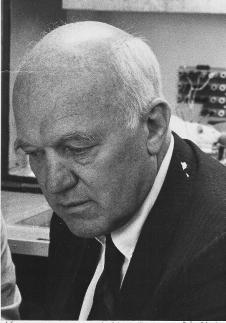
Neal Elgar Miller (1909-2002)
On August 3, 1909, American experimental psychologist and neuroscientist Neal Elgar Miller was born. Miller is best known for being the first to identify and promote biofeedback. He demonstrated experimentally that individuals may learn to control their heart rate and digestion in the same sense that walking is a learned activity.
Youth and Education
Neal E. Miller was born in Milwaukee, Wisconsin, and grew up in the Pacific Northwest, where his father, Irving Miller, worked at Western Washington University as Chair of the Department of Education and Psychology. Originally having a curiosity for science, Miller entered the University of Washington in 1931, where he studied biology and physics. His senior year he decided that psychology would allow him to pursue his wide variety of interests. He graduated from the University of Washington with a B.S. and a piqued interest in behavioral psychology. He continued as graduate student at Stanford University, where he received his M.S. and an interest in psychology of personality.
Behaviour and Motivation
At Stanford he accompanied his professor, Walter Miles, to the Institute of Human Relations at Yale University as a research assistant, where he further studied psychoanalysis. He received his Ph.D. degree in Psychology from Yale University in 1935. Miller’s early work focused on experimenting with Freudian ideas on behavior in real-life situations.[4] His most notable topic was fear. Miller came to the conclusion that fear could be learned through conditioning. Miller then decided to extend his research to other autonomic drives, such as hunger, to see if they worked in the same way. His unique ideas and experimental techniques to study these autonomic drives resulted in findings that changed ideas about motivations and behavior.
Social Learning and Imitation
Already in 1935, Neal Miller became a social science research fellow at the Institute of Psychoanalysis in Vienna before returning to Yale as a faculty member in 1936. During World War II, Miller served as an officer in charge of research in the Army Air Corps’ Psychological Research Unit #1 in Nashville, Tennessee. After that he was director of the Psychological Research Project at the headquarters of the Flying Training Command in Randolph Field, Texas.[1] Along with John Dollard, Miller combined Freud’s ideas with learning theory. In Social Learning and Imitation (1941) and Personality and Psychotherapy (1950), he and Dollard presented their research results, which suggested that behaviour patterns were produced through the modification of biologically or socially derived drives by conditioning and reinforcement. Miller and Dollard coined the Frustration-Aggression Hypothesis. In its original form it stated that frustration always causes aggression and aggression is always a consequence of frustration.[1]
30 Years at Yale
Neal Miller spent a total of 30 years at Yale University (1936–1966), and in 1950 he was appointed professor at Yale, a position he held until 1966. In 1966 he began teaching at Rockefeller University and afterwards spent the early 1970s teaching at Cornell University Medical College. He became Professor Emeritus at Rockefeller in 1981 and Research Affiliate at Yale in 1985.
The Theory of Biofeedback
Miller was also one of the founding fathers behind the idea of biofeedback. He was among the first scientists who conducted research on rats in which he stimulated rats’ brains by using electricity or chemicals to produce such sensations as hunger or anxiety.[1] Today, many of his ideas have been expanded and added to, but Miller has been credited with coming up with most of the basic ideas behind biofeedback. Miller was doing experimentation on conditioning and rats when he discovered biofeedback.
Integration of Behavioral and Psychoanalytic Concepts
Neal Miller, along with John Dollard and O. Hobart Mowrer, helped to integrate behavioral and psychoanalytic concepts. They were able to translate psychological analytic concepts into behavioral terms that would be more easily understood. Specifically, they focused on the stimulus-response theory. These three men also recognized Sigmund Freud’s understanding of anxiety as a “signal of danger” and that some things in Freud’s work could be altered to fix this. Miller, Dollard and Mowrer believed that a person who was relieved of high anxiety levels would experience what is called “anxiety relief”. Miller also started to face significant criticism in academic community. He claimed that people could directly influence their bodily mechanisms, such as blood pressure, and that everybody could be taught to do so. The idea was so radical and novel that it bordered on scientific heresy.[1] Biofeedback is now used fairly widely to help with a variety of medical conditions, including migraines, epilepsy and high blood pressure. Miller’s regular use of laboratory animals, over many years, aroused criticism from animal rights groups, but he was a forthright defender of the practice[2]
Over the course of his career, Miller wrote eight books and 276 papers and articles. Neal Miller died on March 23, 2002, aged 92.
PSY405 Lecture 34,35 || THE STIMULUS RESPONSE THEORY OF DOLLARD AND MILLER || By Conceptsbuilder, [7]
References and Further Reading:
- [1] Neal E. Miller, at New World Encyclopaedia
- [2] Nagourney, Eric (2 April 2002). “Neal E. Miller is dead at 92; studied brain and behavior”. The New York Times.
- [3] Edgar E. “Ted” Coons, Neal Elgar Miller, Biographical Memoirs, National Academy of Sciences
- [4] Freudian Slips and other Trifles, SciHi Blog
- [5] Neal E. Miller at Wikidata
- [6] “Neal Miller: 100 year anniversary”. nealmiller.org.
- [7] PSY405 Lecture 34,35 || THE STIMULUS RESPONSE THEORY OF DOLLARD AND MILLER , Concepts Builder ❤️ @ youtube
- [8] Mook, Douglas G. (2004). “Neal Miller”. Classic experiments in psychology. Westport, CT: Greenwood Press.
- [9] Timeline for Neal E. Miller, via Wikidata






Pingback: Whewell’s Gazette: Year 03, Vol. #51 | Whewell's Ghost